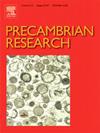The significance of Archean sanukitoids in the cratonization process: The example of the Barlow pluton, between the Abitibi and Opatica subprovinces, Superior Craton, Quebec
IF 3.2
2区 地球科学
Q2 GEOSCIENCES, MULTIDISCIPLINARY
引用次数: 0
Abstract
Much debate surrounds Archean crustal growth and its evolution, as well as processes leading to the stabilization of the crust (cratonization). The Barlow pluton is a late-tectonic granitoid that intrudes into the boundary between the Abitibi greenstone belt and the Opatica plutonic belt (Québec, Canada), two subprovinces that make up the southeastern part of the Superior Craton. The Barlow pluton and the Maaskitkuu tonalite, one of its host rocks, are useful to improve the understanding of tectonic and magmatic processes along the margins of subprovinces in Archean cratons. Here, whole-rock analyses, dating (U-Pb on zircon) and barometry on amphibole are used to define the petrogenesis of these two plutons. The older Maaskitkuu tonalite (ca. 2705 Ma) belongs to a Tonalite-Trondhjemite-Granodiorite (TTG) intrusive suite and has a high Sr/Y ratio. The Barlow pluton (ca. 2696 Ma) belongs to the sanukitoid group. The Maaskitkuu tonalite emplaced 10 km deeper than the Barlow pluton, pointing to the exhumation of 10 km of rocks in about 11 Ma, corresponding to an exhumation rate of 1.37 mm/yr. When combined with previous structural and seismic studies, the observations support an imbrication of terranes farther to the north and the south to explain the arrangement of both subprovinces, marked by a transcrustal structure. This structure allows melts from the lower crust and the metasomatized mantle to ascend toward the upper crust promoting the cratonization.
太古宙sanukitoids在克拉通化过程中的意义:以魁北克省上克拉通Abitibi和Opatica副省之间的Barlow岩体为例
围绕太古代地壳生长及其演化,以及导致地壳稳定的过程(克拉通化),有很多争论。巴洛岩体是一种晚期构造花岗岩类岩体,侵入了构成上克拉通东南部的阿比提比绿岩带和奥帕提卡岩体带(加拿大qusamubec)的交界。Barlow岩体及其主岩之一Maaskitkuu闪长岩对于提高对太古宙克拉通次省边缘构造和岩浆作用的认识具有重要意义。本文采用全岩分析、锆石U-Pb测年和角闪洞气压测定等方法确定了这两个岩体的成因。古马斯基特库闪长岩(约2705 Ma)属于闪长岩-特龙闪长岩-花岗闪长岩(TTG)侵入套,具有较高的Sr/Y比值。巴洛岩体(约2696 Ma)属于类sanukitoid群。Maaskitkuu闪长岩比Barlow闪长岩位深10 km,表明在约11 Ma的时间内挖掘了10 km的岩石,对应的挖掘速率为1.37 mm/yr。当与先前的构造和地震研究相结合时,这些观测结果支持向北和向南更远的地体叠瓦,以解释两个副省的安排,以跨地壳结构为标志。这种构造允许下地壳和交代地幔的熔体向上地壳上升,促进克拉通化。
本文章由计算机程序翻译,如有差异,请以英文原文为准。
求助全文
约1分钟内获得全文
求助全文
来源期刊

Precambrian Research
地学-地球科学综合
CiteScore
7.20
自引率
28.90%
发文量
325
审稿时长
12 months
期刊介绍:
Precambrian Research publishes studies on all aspects of the early stages of the composition, structure and evolution of the Earth and its planetary neighbours. With a focus on process-oriented and comparative studies, it covers, but is not restricted to, subjects such as:
(1) Chemical, biological, biochemical and cosmochemical evolution; the origin of life; the evolution of the oceans and atmosphere; the early fossil record; palaeobiology;
(2) Geochronology and isotope and elemental geochemistry;
(3) Precambrian mineral deposits;
(4) Geophysical aspects of the early Earth and Precambrian terrains;
(5) Nature, formation and evolution of the Precambrian lithosphere and mantle including magmatic, depositional, metamorphic and tectonic processes.
In addition, the editors particularly welcome integrated process-oriented studies that involve a combination of the above fields and comparative studies that demonstrate the effect of Precambrian evolution on Phanerozoic earth system processes.
Regional and localised studies of Precambrian phenomena are considered appropriate only when the detail and quality allow illustration of a wider process, or when significant gaps in basic knowledge of a particular area can be filled.
 求助内容:
求助内容: 应助结果提醒方式:
应助结果提醒方式:


